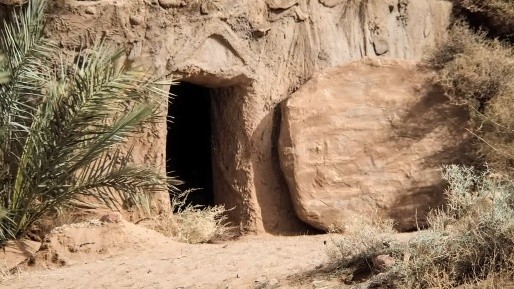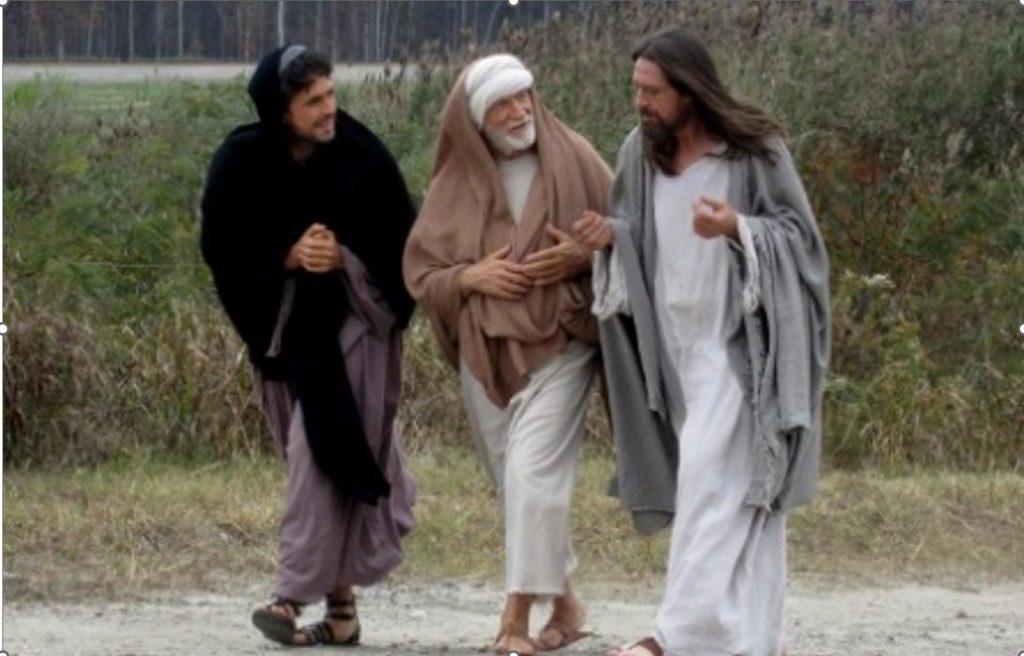
See today’s show at:
There’s no question that the bodily resurrection of Jesus Christ, with a body that can never die again (Ro 6:9) and has now been ‘transported’ to another non-earthly realm in heavenly places (Heb 1:3, 8:1), is the most fantastical part of true history that the world has ever known. It should be no small wonder to anyone that that fact became the reasonable justification for all humanity to reset our calendars so that we are now all living in the year of our Lord.. number 2025. Think about that! Shouldn’t the fact that most of the human family haven’t heard and don’t believe it yet .. compel all of us who claim to be Christ’s redeemed children .. to reconsider the reasons why we all have a mission to share with others the awesome hope for our own future resurrected and eternal life with our Savior (John 11:25-26)?
So, what do we need to know about how to share this most amazing ‘good news’ (gospel) with others who don’t know it yet?
It is a fact that nowhere in the Hebrew Scriptures of our Old Testament Bible can we find a direct prophecy that can be construed as a promise of the Messiah’s future resurrection. That’s why it’s reasonable to suspect that Satan really thought he could get away with orchestrating the unlawful murder of Jesus, the Christ. How puzzled do you think Satan was when he heard Jesus openly say this to a mixed crowd of people, as recorded in the 10th chapter of John’s gospel?
“The Father loves me because I sacrifice my life so I may take it back again. No one can take my life from me. I sacrifice it voluntarily. For I have the authority to lay it down when I want to and also to take it up again. For this is what my Father has commanded.” Jn 10:17-18
Remember this statement from the apostle Paul?
“…the wisdom we speak of is the mystery of God—his plan that was previously hidden, even though he made it for our ultimate glory before the world began. But the rulers of this world have not understood it; if they had, they would not have crucified our glorious Lord.” 1 Cor 2:7-8
Resurrection Hints in Old Testament
However, the resurrection of Christ is hinted at in the Old Testament through various metaphors and prophecies. Significantly, Ezekiel sees a vision of dry bones coming “up from their graves,” symbolizing God’s power to restore life and bring his people back to their promised land (Ezekiel 37:1-14).
Isaiah speaks of resurrection when he says, “Your dead shall live; their bodies shall rise … and the earth will give birth to the dead” (Isa 26:19)..
Daniel 12:2 is another clear reference to resurrection, asserting, “And many of those who sleep in the dust of the earth shall awake, some to everlasting life, and some to shame and everlasting contempt.” This prophecy is specifically affirmed by Jesus and Paul in the New Testament (John 5:29; Acts 24:15).
These passages, while not directly mentioning the resurrection of Christ, provide at least a foundation for the concept of resurrection. They hint at the power of God to restore life, which is central to the Christian belief in the resurrection of Jesus Christ.
In the context of the Old Testament, resurrection hope is tied to the faithfulness and power of Yahweh, who is able to keep his promises and bring life where there was death.
Think about these ideas of resurrection biblically. We realize the historic reality of the resurrection of Jesus of Nazareth almost 2,000 years ago was absolutely revolutionary to all human understanding of truth, reality, and life itself.
So, WHAT EVIDENCE DO WE HAVE THAT JESUS ROSE FROM THE DEAD?
[The following observations were gathered from an essay by Dr. Peter Hammond, my evangelist friend in South Africa.]
In his appeal to his fellow Jews to find Christ to be the “end of the law for righteousness to everyone who believes,” the apostle Paul wrote one of the most familiar passages for Christians in Romans 10.
“But what does it say? ‘The word is near you in your mouth and in your heart’ – that is, the word of faith which we are preaching, that if you confess with your mouth Jesus as Lord, and believe in your heart that God raised Him from the dead, you shall be saved.’” Ro 10:8-9
How important is Christ’s resurrection to our personal faith?

Personal confession of Christ’s lordship is intimately connected to our deeply held conviction that Jesus has really been raised from the dead in resurrection life by Almighty God. He even goes on to say that all-in, heart-felt belief is the catalyst that actually results in righteousness – certainly right-standing with God, if not also the strong inclination to successfully live a godly and righteous life. Shouldn’t that describe you if you’re expecting to be saved?
Paul’s first epistle to the Corinthians includes the famous ‘resurrection chapter,’ chapter 15. He starts with a declaration of Number One importance that Christ died for our sins according to many direct and indirect prophetic scriptures of the Old Testament. But he also claims that He was raised on the third day in accordance with ancient scriptures, ostensibly the writings of Moses and the Jewish prophets.
“For I delivered to you as of first importance what I also received, that Christ died for our sins according to the Scriptures, and that He was buried, and that He was raised on the third day according to the Scriptures, and that He appeared to Cephas, then to the twelve. After that He appeared to more than five hundred brethren at one time…” 1 Co 15:3-6a

Much of the Mosaic tabernacle system in the Old Testament pointed to the sacrifice of Messiah as our redeeming substitute and Savior. The annual day of Atonement (Lev 16) and prophecies like Isaiah 53 are two good examples. But where does the Old Testament declare Christ’s resurrection on the third day? It doesn’t – at least not directly. You have to think like a detective here.
Remember how Jesus pointed to the experience of Jonah (Matt 12:38-41)? That’s a big clue from the One who was going to die and resurrect himself. Paul compared Christ’s resurrection to the “firstfruits (1 Cor 15:23).” Firstfruits were presented to God at His temple on the day after the Sabbath after Passover (Lev 23:9-14). Since Sabbath must always be the seventh day, the day after Sabbath must be the first day of the week, the day Jesus resurrected. This had to cover at least 3 full days on the Jewish calendar. Other Old Testament prophecies of Messiah’s resurrection are implied in Psalm 16:10 (see Acts 2:25-28); and Isaiah 53:8-10.
The most important verse in 1 Corinthians 15 regarding Christ’s resurrection is verse 17.
“If Christ has not been raised, your faith is worthless; you are still in your sins.” 1 Co 15:17.
If this is true, and we can’t be absolutely confident Jesus actually did resurrect in bodily form from his grave, never to die again… we’ll have serious hurdles believing almost any of God’s promises we haven’t yet seen fulfilled.
The Resurrection is truly the chief cornerstone of the gospel of Jesus Christ and His kingdom. That’s obviously why Paul repeated the phrase when he wrote Timothy…
“Remember that Jesus Christ of the seed of David was raised from the dead according to my gospel.” 2 Ti 2:8
Do you think it’s highly important that we help those who are new in their faith to KNOW the facts that give them courage to stand against all skeptics who would try to demolish their faith in Jesus?

Once we’ve studied Bible history enough to be personally satisfied that the written records of the first century books of the New Testament are accurate and reliable, we should be honest enough to ‘test all things’ and examine the facts carefully. Then we’ll see how it all makes sense.
Who Moved the Stone?
The Resurrection of Jesus is so foundational to the gospel that you can just imagine why it’s the continuing target of endless attacks by skeptics of every generation for 2,000 years. Frank Morison, an early 20th century English writer, was raised as a rationalistic skeptic. He planned writing a refutation of the resurrection by recounting the tragic last days of Jesus, emphasizing the full horror of the crime and the full heroism of Jesus, but omitting any suspicion of the miraculous. However, his meticulous research led him to personal faith in Christ and the publication of his book, “Who Moved the Stone?” in 1930. He demonstrates definitively the overwhelming evidence for the Resurrection.
Undeniable Evidence that Demands a Verdict

A skeptical grad student in 1970, Josh McDowell, determined to disprove Christianity by investigating evidence against the Resurrection. The result was his conversion to Christ and the publishing of his monumental book: “Evidence That Demands a Verdict.” It’s a classic that every student of the Bible should study. It thoroughly presents documentation and extensive evidence to substantiate the historical truth of the Bible. Archeological and manuscript evidences, along with itemized fulfilled prophecies and testimonies of transformed lives, give strong support to the fact of Jesus’ resurrection and the truth claims of Christianity.
Let’s Examine the Evidence
[1st Century Jewish historian, Flavius Josephus’ Account of Jesus – The Testimonium Flavianum]
There are no surviving Roman records of the First Century that refer to, nor are there any Jewish records that support the accounts in the Christian gospels — except one.
In Rome, in the year 93AD, Flavius Josephus published his lengthy history of the Jews. His discussion of the period when the Judaea Jews were governed by the Roman procurator Pontius Pilate, Josephus included the following account:

“Now there was about this time Jesus, a wise man; if it be lawful to call him a man. For he was a doer of wonderful works; a teacher of such men as receive the truth with pleasure. He drew over to him both many of the Jews, and many of the Gentiles. He was [the] Christ. And when Pilate, at the suggestion of the principal men among us, had condemned him to the cross; those that loved him at the first did not forsake him. For he appeared to them alive again, the third day: as the divine prophets had foretold these and ten thousand other wonderful things concerning him. And the tribe of Christians, so named from him, are not extinct at this day.“
https://www.gutenberg.org/files/2848/2848-h/2848-h.htm
You just heard a personal account from the first century… not from the Bible… confirming the marvelous records of true history we find in the New Testament gospel accounts.
What are the Facts?
The religious leaders in the days of Jesus’ controversial ministry conspired to have Christ arrested and executed on trumped up charges. They obviously had a compelling interest to disprove any claims of the Resurrection. They fully expected executing Jesus would eliminate his threat to their religious power base and silence His disciples. Those corrupted religious leaders had great concerns about the dead body of Jesus. They were so nervous about Jesus’ wide popularity that they interceded with the Roman governor, Pontius Pilate, asking for a military detachment to guard the tomb (Matthew 28:62–64) against grave robbers.
The Roman governor’s priority in the volatile province of Palestine was preserving peace and stability. He knew political problems could ensue if anything happened to the body of the religious Teacher whom he had declared innocent three times. That’s why he ultimately washed his hands in front of the crowd declaring, “I’m innocent of this Man’s blood” (Matthew 27:24).
Just think about it. Pilate was very aware that a travesty of justice had taken place. To keep his military position in the Roman system, the last thing he needed was a government-ordered investigation of his shameful conduct and a negative review. Ensuring the victim’s corpse remained buried was Pilate’s eminent thought to maintain Caesar’s approval. Matthew reports that Pilate ordered the assignment of an official military guard, “So, they went and made the tomb secure by putting a seal on the stone and posting the guard.” Matthew 27:65
The Roman Guard
When the chief priests approached the Roman governor, the Greek word Koustodia is used to describe the detachment of soldiers, identifying that it was a Roman guard. If only a temple guard was used, they wouldn’t have needed to ask Pilate to issue the order. After the Resurrection, the worry of the guards to be protected from punishment for slacking off (Matthew 28:14) confirms that those guarding the tomb were Roman soldiers. The detachment would have been at least 16 soldiers. Four men were posted right in front of the tomb at all times. Roman military law decreed that any guard deserting his post, or who fell asleep on duty, faced crucifixion. Anyone who dared to break a Roman seal without permission would be tracked down and executed.
No one doubts that the intentions of the religious and political leaders in Jerusalem were to be sure that the extraordinary public ministry and popularity of Jesus ended at the tomb. But their surprisingly excessive security measures have only confirmed the truth that they had murdered an innocent Man and that Jesus Christ was truly the Messiah, the Son of the Living God.
Would you Die for a Lie?
In their desperate efforts to explain away the empty tomb, enemies of the Gospel have resorted to some pretty ridiculous schemes and propaganda. The first was to impress everyone that the closest disciples of Jesus had dared to steal His body. This far-fetched theory suggests that the same disciples who failed to stay awake to pray with their Lord in the garden of Gethsemane and fled when He was arrested, suddenly transformed into a team of brave Chuck Norris warriors. Think about this. After publicly denying Jesus to a young woman, and hiding for fear of also being caught and crucified, would they all overcome professional Roman soldiers, dare to break a Roman seal, and move a two-ton tombstone, just to steal a corpse! How would a dead Messiah do anything good for a terrified bunch of young disciples of a defeated rabbi? What plan could possibly motivate them, even if they had the ability to overcome the military, political and logistical obstacles? They had nothing to gain and everything to lose.
You might hear idiotic complainers scornfully taunt with “Did Jesus Really Die?”
Over the years, some skeptics have questioned whether Christ really died on the Cross. Maybe He only fainted? This swoon theory would have us believe that the Roman soldiers, who were professional killers, failed to ensure that this high-profile political prisoner was not actually dead. The centurion in charge, would most probably have supervised dozens if not hundreds of executions before this one. Considering the vicious flogging which the Lord had already endured, the excruciating torture of crucifixion, and the spear thrust into His side, with blood and water flowing out, all provide convincing evidence of His death to everyone around at the time.
Yet, those promoting the swoon theory would have us believe what is pathetically absurd. They suppose that the One Who endured a savage flogging, an hours-long crucifixion, and a spear wound to his heart, could not only survive the legendary Roman military torturous slow death, but that He miraculously revived on a cold slab in a pitch-dark cold tomb, only to eventually die again at some later date that was never documented by anyone. Furthermore, He somehow detached himself from the grave clothes, smothered in a hundred pounds of spices and aloe that effectively mummified Him. Then He rolled away the two-ton stone, overpowered the Roman soldiers, and somehow convinced the rest of the disciples that Jesus was God? It doesn’t take a very bright college student to recognize that a conspiracy theory like that is worse than stupid… it’s downright deranged!
The Empty Tomb
Another desperate attempt to explain away the Resurrection of Christ has been that they went to the wrong tomb. All of them – Mary Magdalene, Peter, John, the other women – all went to the wrong tomb. And somehow neither the Pharisees, nor the Sadducees, nor the Roman soldiers, nor the owner of the tomb, Joseph of Arimathea, had the bright idea to point out that the real tomb was still occupied with the body of the missing Messiah! How would you show that this theory is also impossible rubbish? Just remind people that this tomb was not in a cemetery. It was in a garden, privately owned by Joseph of Arimathea. Do you know any men who are rich enough to have a grave like that? How could they miss the fact that there were no other tombs in that garden?
The proof positive for the resurrection “theory” – the Absence of the Body
All the Roman and Jewish leaders had to do to forever end what would become the cornerstone of the biggest religion in the world was produce the corpse of Jesus. But they couldn’t do it. Even when the Apostle Peter stood up on the day of Pentecost and proclaimed: “Therefore, let all the house of Israel know assuredly that God has made this Jesus, whom you crucified, both Lord and Christ” Acts 2:36. “And with great power the apostles gave witness to the Resurrection of the Lord Jesus” Acts 4:33. Many thousands in Jerusalem, including many Pharisees, came to unstoppable faith in Jesus Christ.
As we all should know, rejoicing is in order when arrogant elitists get exposed in a Crisis of Credibility
To the Jewish religious leaders, this was their worst nightmare. 50 days after the resurrection at Pentecost (Shavuot), when thousands gathered in Jerusalem for the holiday… the public proclamation of the Resurrection of Christ embarrassingly undermined their corrupted political power and credibility. Thousands of their followers now believed that they really had participated in the condemnation of an innocent Man, the Messiah Himself. The new way of seeing the mystery of Messianic scriptures fulfilled in their resurrected Messiah, named Yeshua, was undermining the power base and credibility of the satanically driven Pharisees and Sadducees. If the body of Jesus could have been found, there never would have been the formation of a Christian ‘religion’ under an institutionalized hierarchy of bishops three centuries later. The perceived threat to the Jewish religious status quo would have ended 40 years before the providential destruction of what’s called the second temple in Jerusalem in 70AD. They used every means possible to find the corpse – if that were possible. But they had other problems besides.
The Testimonies of Eyewitnesses

The compromised, self-righteous Jews running the show in 30AD, not only had to explain the empty tomb and the absence of Jesus’ body, they also had to deal with the confident testimonies of living eyewitnesses. On at least twelve separate historically recorded occasions Jesus Christ was seen after rising from the tomb. You can look them all up in the list from today’s transcript … All saw the Lord bodily raised from the dead.
[Mary Magdalene (John 20:11–18; Mark 16:9); the other women (Matthew 28:8–10); Peter (Luke 24:34); the two disciples on the road to Emmaus (Luke 24:13–35); ten of the disciples (Luke 24:36–43; John 20:19–24); all eleven disciples, eight days later (John 20:24–29); seven disciples by the Sea of Tiberius (John 21:1–23); to 500 at one time (1 Corinthians 15:6); to James (1 Corinthians 15:7); to all 11 apostles, and others, at the Ascension (Acts 1:3–12); Paul (Acts 9:3–8); and John (Revelation 1:12–18).]
To explain away the testimony of all these eyewitnesses, enemies of Christianity have sometimes insisted all these people were hallucinating. Theories about these people being under some kind of mass hypnosis or hysteria have been used to try to dissuade would-be believers from falling for the claims of the gospel. However, while hallucinations tend to be unique psychological experiences of individuals, this is a completely different story. We’re dealing with a large number of people who saw the Lord. They occurred at different times of the day, in different groups, and in different places. They happened indoors and outdoors. They even ate with Him, and saw the wounds in His hands and His side.
And far from being gullible, it appears from the recorded accounts that His disciples were very skeptical and slow to believe. Thomas declared that he would not believe that Christ had risen unless he personally placed his fingers in the nail prints in His hands and feet, and even put his hand in the wound in His side.
The Transformation of the Disciples is too compelling to be fake
The dramatic transformation of those disciples is just too compelling to be explained by something that didn’t really happen. The Resurrection of Christ from the dead transformed the disciples’ grief to joy. Their cowardice was miraculously morphed into boldness. Their skepticism was overwhelmed by unimaginable faith. Their serious doubt dissolved into peaceful yet unfaltering determination. Unimaginable new reality turned Saul, the persecutor of the Way, into Paul the apostle of the Ekklesia of God and ambassador for His kingdom.
The Resurrection transformed society and history.
If you were to think about it… what would the world be like if Jesus’ resurrection did not make such a fundamentally profound impact on first century believers?
When you begin to understand the divinely providential development of the history of the world, you see the reality around you through entirely different lenses.
The Resurrection transformed Theology:
Only the resurrection of Jesus can be seen as the ultimate validation of his claims to be God’s Messiah for all mankind regardless of the ‘religion’ by which you were raised by your parents and your culture. Messiah’s resurrection confirmed that He alone was indeed the one promised in the Hebrew Scriptures, who would bring salvation to reconcile all humanity with God. It firmly established the belief that Jesus was not just a Semite prophet or good teacher, but the divine Son of God.
The resurrection instantly became the Foundational truth of the Early Church:
The disheartened and fearful disciples after Jesus’ crucifixion, were emboldened by the resurrection. They immediately began preaching the message of Jesus’ death and resurrection. Their unshakeable confidence persuasively forged the rapid spread of Christianity across the Roman Empire and beyond.
The Resurrection encouraged Ethical and Moral Transformation:
The resurrection became a call to a new way of living. It inspired early Christians to live lives characterized by love, compassion, and service to others. The teachings of Jesus, particularly those about forgiveness, long-suffering, social kindness and charity, became central to the framework of the early Christian community.
The Resurrection birthed a new Eschatological Hope:
The resurrection instilled a completely innovative sense of hope in the early Christian community regarding the future. It reinforced the belief in the ultimate triumph of good over evil and the promise of eternal life. This hope for a divine future has comforted and motivated Christians throughout history, especially in times of persecution and hardship.
The Resurrection had a major Cultural and Social Influence:
The dispersal of Christianity, rooted in the dominant belief in Jesus’ resurrection, had a revolutionary impact on Western civilization. It influenced the development of art, literature, philosophy, and even science. It radically changed everything, giving birth to new social institutions. The values and principles derived from the teachings of Christ and His kingdom, have shaped legal systems and governments, educational institutions and social welfare ideology.
The resurrection of Jesus was more transformative than any single event in history. It not only validated Jesus’ messianic claims; it also gave rise to what has become the largest religious movement in the history of the world with over 2 billion people worldwide who describe themselves as Christians who believe in the Resurrection of Christ.
Paul’s epistle to the Roman believers opens with his declaration about God’s son, Jesus Christ our Lord. He affirms that Jesus is “declared to be the Son of God… by the resurrection from the dead” (Ro 1:3-4).
The last enemy that shall be destroyed is death” (1 Cor 15:26), and since only Almighty God Himself can conquer death, Christ’s bodily resurrection is THE conclusive affirmation of His unique deity.
Peter’s confession (Matt 16:16), “Thou art the Christ, the Son of the living God,” is possibly the most profound revelation ever proclaimed by one man’s epiphany. Many others have claimed divine sonship, but all are dead. Only Christ validated that claim by defeating death. As Paul testified to the synagogue gathering in Antioch, “God … hath raised up Jesus again; as it is also written in the second psalm, Thou art my Son, this day have I begotten thee.”
Indeed, “Death is swallowed up in victory… through our Lord Jesus Christ” (1 Cor 15:54, 57).
No wonder, the final Revelation for the new heaven and earth includes the proclamation…
“And he that sat upon the throne said, Behold, I make all things new. And he said unto me, Write: for these words are true and faithful.”Rev 21:5

Please note: I reserve the right to delete comments that are offensive or off-topic.